BUGEN 5930 Reflective Journal: Sustainable Business Practices
VerifiedAdded on 2023/01/18
|7
|1452
|96
Journal and Reflective Writing
AI Summary
This reflective journal explores the student's evolving understanding of sustainability, initially perceived as individual actions like conserving resources, and later expanded to encompass broader concepts. The journal discusses the impact of consumerism, planned obsolescence, and the limitations of a linear consumption model, referencing Annie Leonard's "Story of Stuff." It examines the role of businesses in driving consumerism and the exploitation of resources and people, while also analyzing the challenges and limitations of corporate sustainability efforts. The journal highlights the importance of the triple bottom line—profit, people, and planet—as a framework for sustainable business practices. The student reflects on the five forms of capital and emphasizes the need for individuals and businesses to consider the environmental and social impact of their decisions, advocating for collective action towards a more sustainable future.
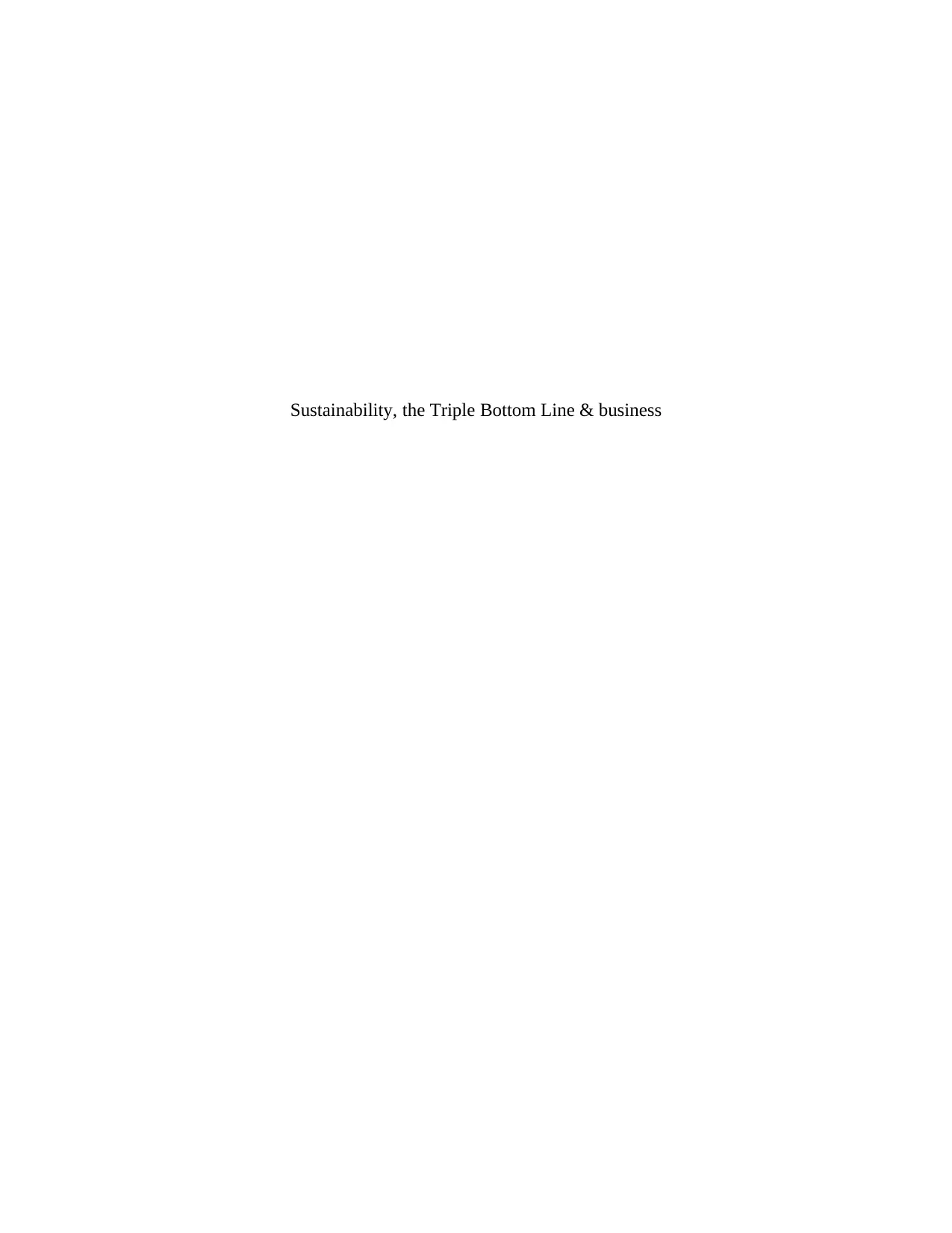
Sustainability, the Triple Bottom Line & business
Paraphrase This Document
Need a fresh take? Get an instant paraphrase of this document with our AI Paraphraser
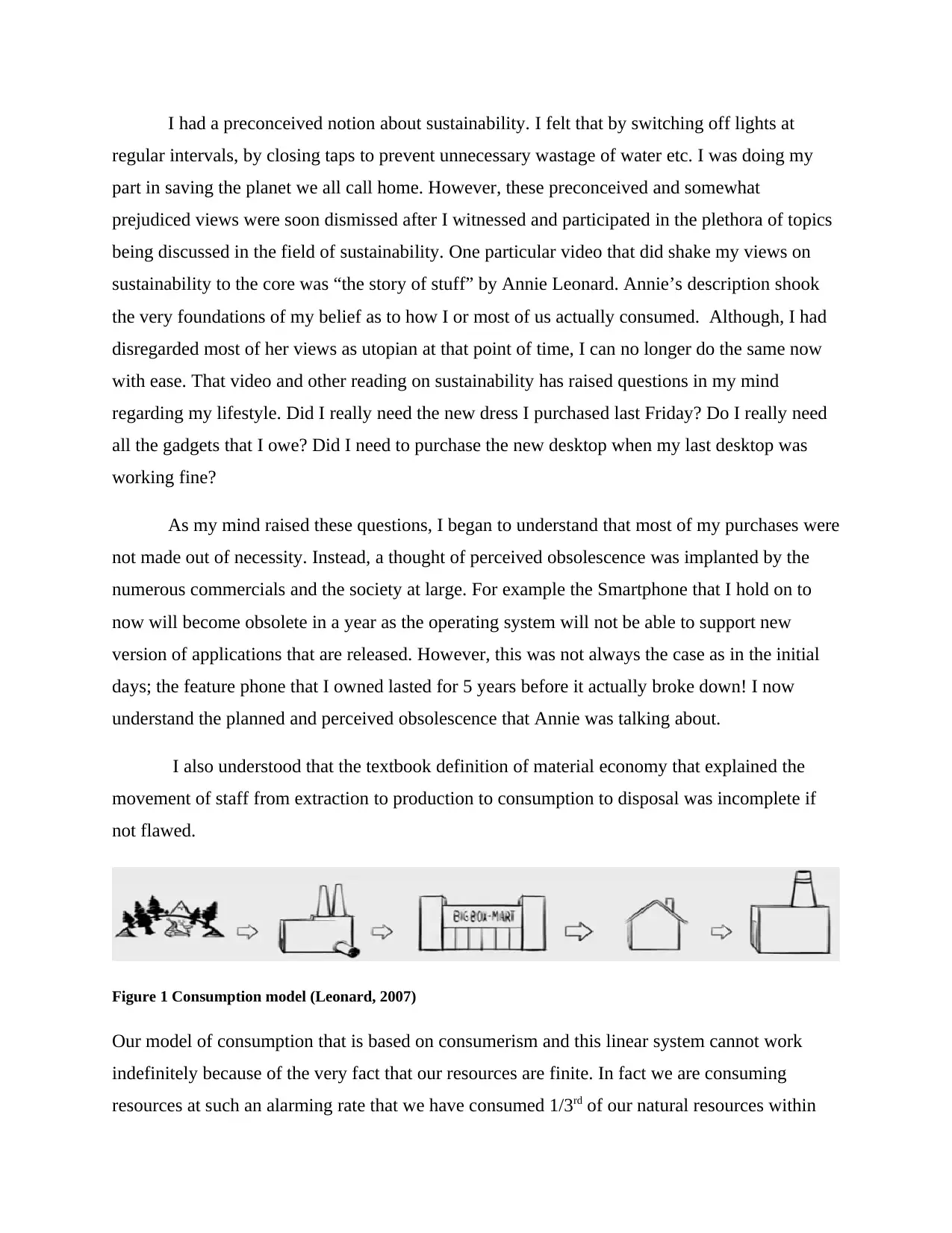
I had a preconceived notion about sustainability. I felt that by switching off lights at
regular intervals, by closing taps to prevent unnecessary wastage of water etc. I was doing my
part in saving the planet we all call home. However, these preconceived and somewhat
prejudiced views were soon dismissed after I witnessed and participated in the plethora of topics
being discussed in the field of sustainability. One particular video that did shake my views on
sustainability to the core was “the story of stuff” by Annie Leonard. Annie’s description shook
the very foundations of my belief as to how I or most of us actually consumed. Although, I had
disregarded most of her views as utopian at that point of time, I can no longer do the same now
with ease. That video and other reading on sustainability has raised questions in my mind
regarding my lifestyle. Did I really need the new dress I purchased last Friday? Do I really need
all the gadgets that I owe? Did I need to purchase the new desktop when my last desktop was
working fine?
As my mind raised these questions, I began to understand that most of my purchases were
not made out of necessity. Instead, a thought of perceived obsolescence was implanted by the
numerous commercials and the society at large. For example the Smartphone that I hold on to
now will become obsolete in a year as the operating system will not be able to support new
version of applications that are released. However, this was not always the case as in the initial
days; the feature phone that I owned lasted for 5 years before it actually broke down! I now
understand the planned and perceived obsolescence that Annie was talking about.
I also understood that the textbook definition of material economy that explained the
movement of staff from extraction to production to consumption to disposal was incomplete if
not flawed.
Figure 1 Consumption model (Leonard, 2007)
Our model of consumption that is based on consumerism and this linear system cannot work
indefinitely because of the very fact that our resources are finite. In fact we are consuming
resources at such an alarming rate that we have consumed 1/3rd of our natural resources within
regular intervals, by closing taps to prevent unnecessary wastage of water etc. I was doing my
part in saving the planet we all call home. However, these preconceived and somewhat
prejudiced views were soon dismissed after I witnessed and participated in the plethora of topics
being discussed in the field of sustainability. One particular video that did shake my views on
sustainability to the core was “the story of stuff” by Annie Leonard. Annie’s description shook
the very foundations of my belief as to how I or most of us actually consumed. Although, I had
disregarded most of her views as utopian at that point of time, I can no longer do the same now
with ease. That video and other reading on sustainability has raised questions in my mind
regarding my lifestyle. Did I really need the new dress I purchased last Friday? Do I really need
all the gadgets that I owe? Did I need to purchase the new desktop when my last desktop was
working fine?
As my mind raised these questions, I began to understand that most of my purchases were
not made out of necessity. Instead, a thought of perceived obsolescence was implanted by the
numerous commercials and the society at large. For example the Smartphone that I hold on to
now will become obsolete in a year as the operating system will not be able to support new
version of applications that are released. However, this was not always the case as in the initial
days; the feature phone that I owned lasted for 5 years before it actually broke down! I now
understand the planned and perceived obsolescence that Annie was talking about.
I also understood that the textbook definition of material economy that explained the
movement of staff from extraction to production to consumption to disposal was incomplete if
not flawed.
Figure 1 Consumption model (Leonard, 2007)
Our model of consumption that is based on consumerism and this linear system cannot work
indefinitely because of the very fact that our resources are finite. In fact we are consuming
resources at such an alarming rate that we have consumed 1/3rd of our natural resources within
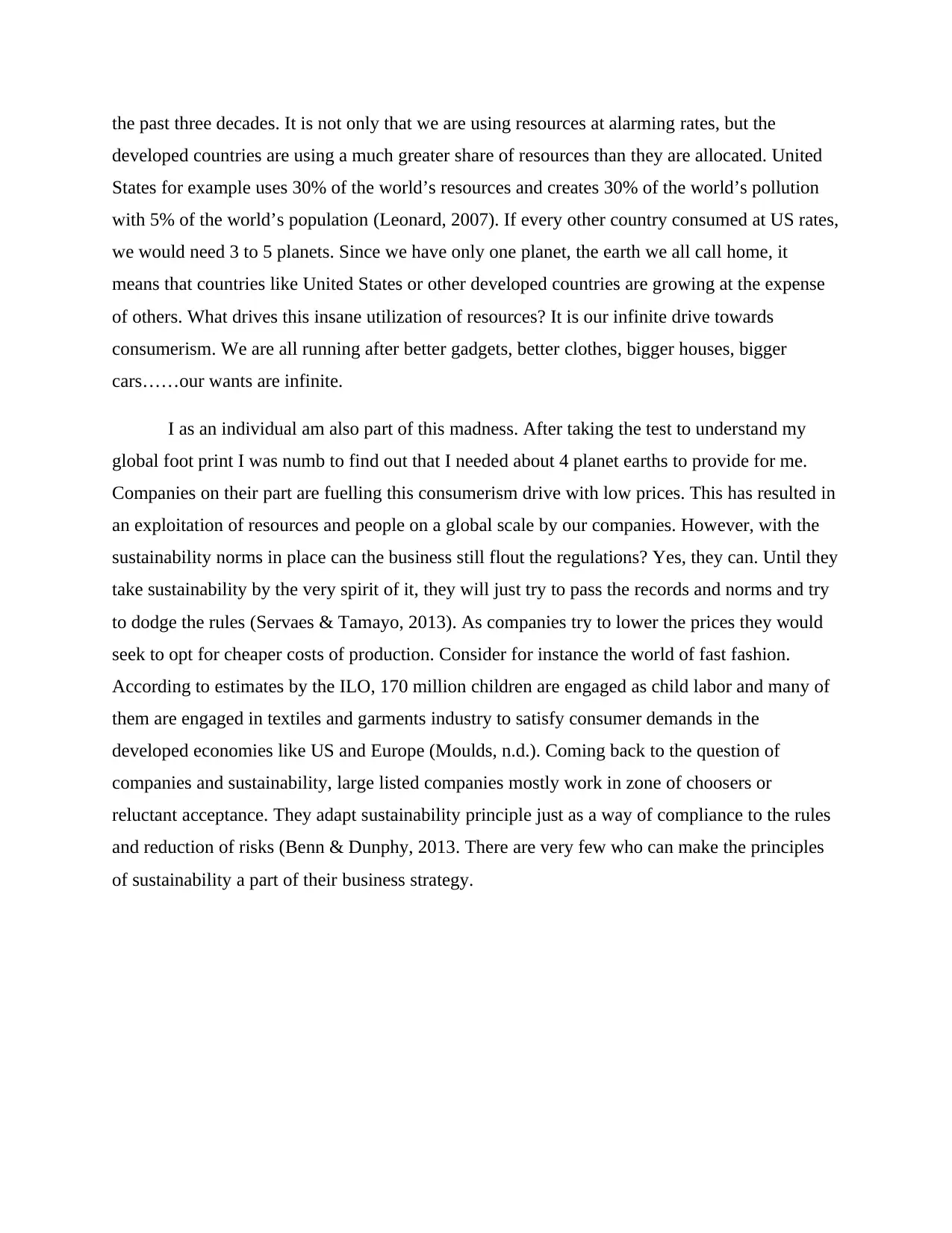
the past three decades. It is not only that we are using resources at alarming rates, but the
developed countries are using a much greater share of resources than they are allocated. United
States for example uses 30% of the world’s resources and creates 30% of the world’s pollution
with 5% of the world’s population (Leonard, 2007). If every other country consumed at US rates,
we would need 3 to 5 planets. Since we have only one planet, the earth we all call home, it
means that countries like United States or other developed countries are growing at the expense
of others. What drives this insane utilization of resources? It is our infinite drive towards
consumerism. We are all running after better gadgets, better clothes, bigger houses, bigger
cars……our wants are infinite.
I as an individual am also part of this madness. After taking the test to understand my
global foot print I was numb to find out that I needed about 4 planet earths to provide for me.
Companies on their part are fuelling this consumerism drive with low prices. This has resulted in
an exploitation of resources and people on a global scale by our companies. However, with the
sustainability norms in place can the business still flout the regulations? Yes, they can. Until they
take sustainability by the very spirit of it, they will just try to pass the records and norms and try
to dodge the rules (Servaes & Tamayo, 2013). As companies try to lower the prices they would
seek to opt for cheaper costs of production. Consider for instance the world of fast fashion.
According to estimates by the ILO, 170 million children are engaged as child labor and many of
them are engaged in textiles and garments industry to satisfy consumer demands in the
developed economies like US and Europe (Moulds, n.d.). Coming back to the question of
companies and sustainability, large listed companies mostly work in zone of choosers or
reluctant acceptance. They adapt sustainability principle just as a way of compliance to the rules
and reduction of risks (Benn & Dunphy, 2013. There are very few who can make the principles
of sustainability a part of their business strategy.
developed countries are using a much greater share of resources than they are allocated. United
States for example uses 30% of the world’s resources and creates 30% of the world’s pollution
with 5% of the world’s population (Leonard, 2007). If every other country consumed at US rates,
we would need 3 to 5 planets. Since we have only one planet, the earth we all call home, it
means that countries like United States or other developed countries are growing at the expense
of others. What drives this insane utilization of resources? It is our infinite drive towards
consumerism. We are all running after better gadgets, better clothes, bigger houses, bigger
cars……our wants are infinite.
I as an individual am also part of this madness. After taking the test to understand my
global foot print I was numb to find out that I needed about 4 planet earths to provide for me.
Companies on their part are fuelling this consumerism drive with low prices. This has resulted in
an exploitation of resources and people on a global scale by our companies. However, with the
sustainability norms in place can the business still flout the regulations? Yes, they can. Until they
take sustainability by the very spirit of it, they will just try to pass the records and norms and try
to dodge the rules (Servaes & Tamayo, 2013). As companies try to lower the prices they would
seek to opt for cheaper costs of production. Consider for instance the world of fast fashion.
According to estimates by the ILO, 170 million children are engaged as child labor and many of
them are engaged in textiles and garments industry to satisfy consumer demands in the
developed economies like US and Europe (Moulds, n.d.). Coming back to the question of
companies and sustainability, large listed companies mostly work in zone of choosers or
reluctant acceptance. They adapt sustainability principle just as a way of compliance to the rules
and reduction of risks (Benn & Dunphy, 2013. There are very few who can make the principles
of sustainability a part of their business strategy.
⊘ This is a preview!⊘
Do you want full access?
Subscribe today to unlock all pages.

Trusted by 1+ million students worldwide
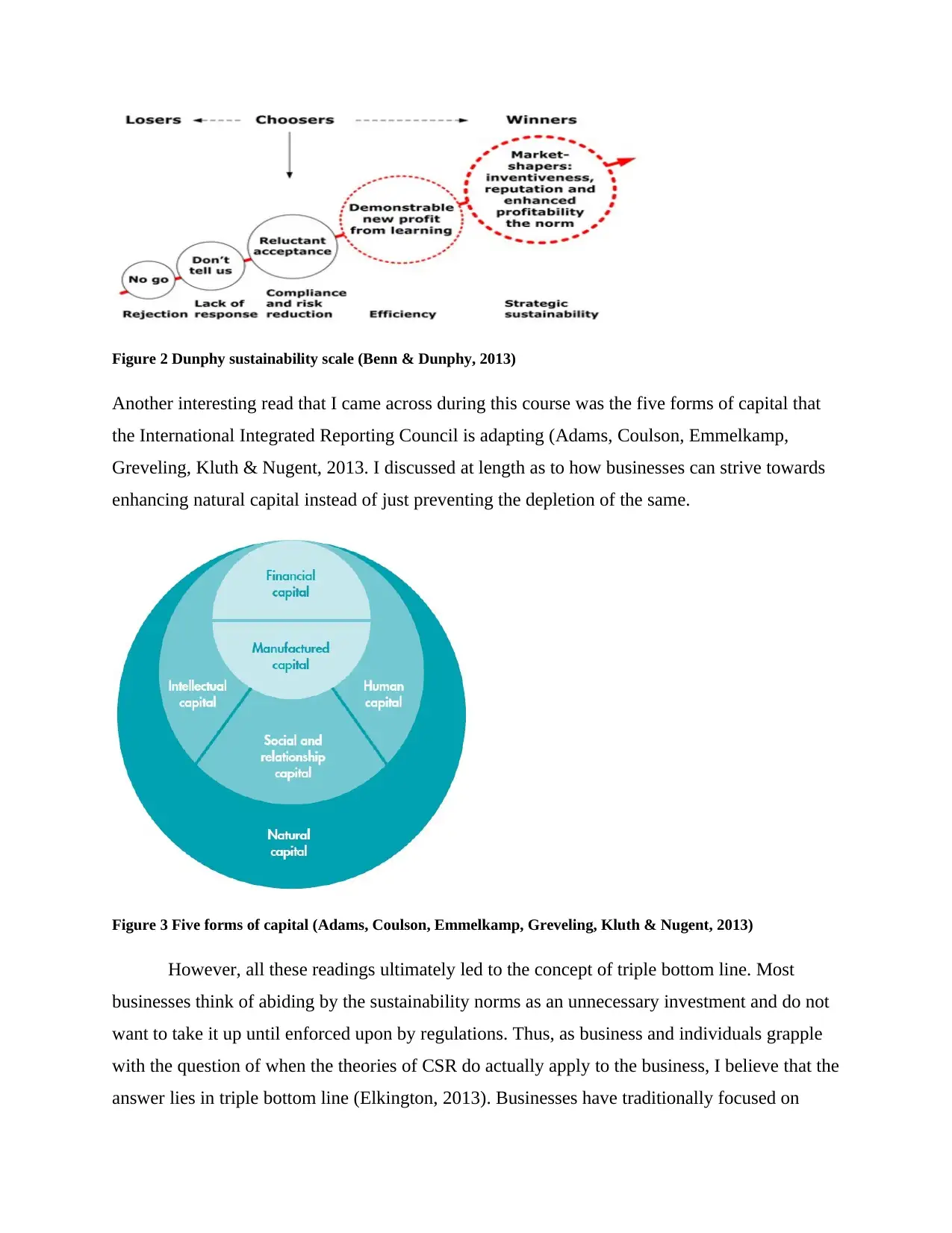
Figure 2 Dunphy sustainability scale (Benn & Dunphy, 2013)
Another interesting read that I came across during this course was the five forms of capital that
the International Integrated Reporting Council is adapting (Adams, Coulson, Emmelkamp,
Greveling, Kluth & Nugent, 2013. I discussed at length as to how businesses can strive towards
enhancing natural capital instead of just preventing the depletion of the same.
Figure 3 Five forms of capital (Adams, Coulson, Emmelkamp, Greveling, Kluth & Nugent, 2013)
However, all these readings ultimately led to the concept of triple bottom line. Most
businesses think of abiding by the sustainability norms as an unnecessary investment and do not
want to take it up until enforced upon by regulations. Thus, as business and individuals grapple
with the question of when the theories of CSR do actually apply to the business, I believe that the
answer lies in triple bottom line (Elkington, 2013). Businesses have traditionally focused on
Another interesting read that I came across during this course was the five forms of capital that
the International Integrated Reporting Council is adapting (Adams, Coulson, Emmelkamp,
Greveling, Kluth & Nugent, 2013. I discussed at length as to how businesses can strive towards
enhancing natural capital instead of just preventing the depletion of the same.
Figure 3 Five forms of capital (Adams, Coulson, Emmelkamp, Greveling, Kluth & Nugent, 2013)
However, all these readings ultimately led to the concept of triple bottom line. Most
businesses think of abiding by the sustainability norms as an unnecessary investment and do not
want to take it up until enforced upon by regulations. Thus, as business and individuals grapple
with the question of when the theories of CSR do actually apply to the business, I believe that the
answer lies in triple bottom line (Elkington, 2013). Businesses have traditionally focused on
Paraphrase This Document
Need a fresh take? Get an instant paraphrase of this document with our AI Paraphraser
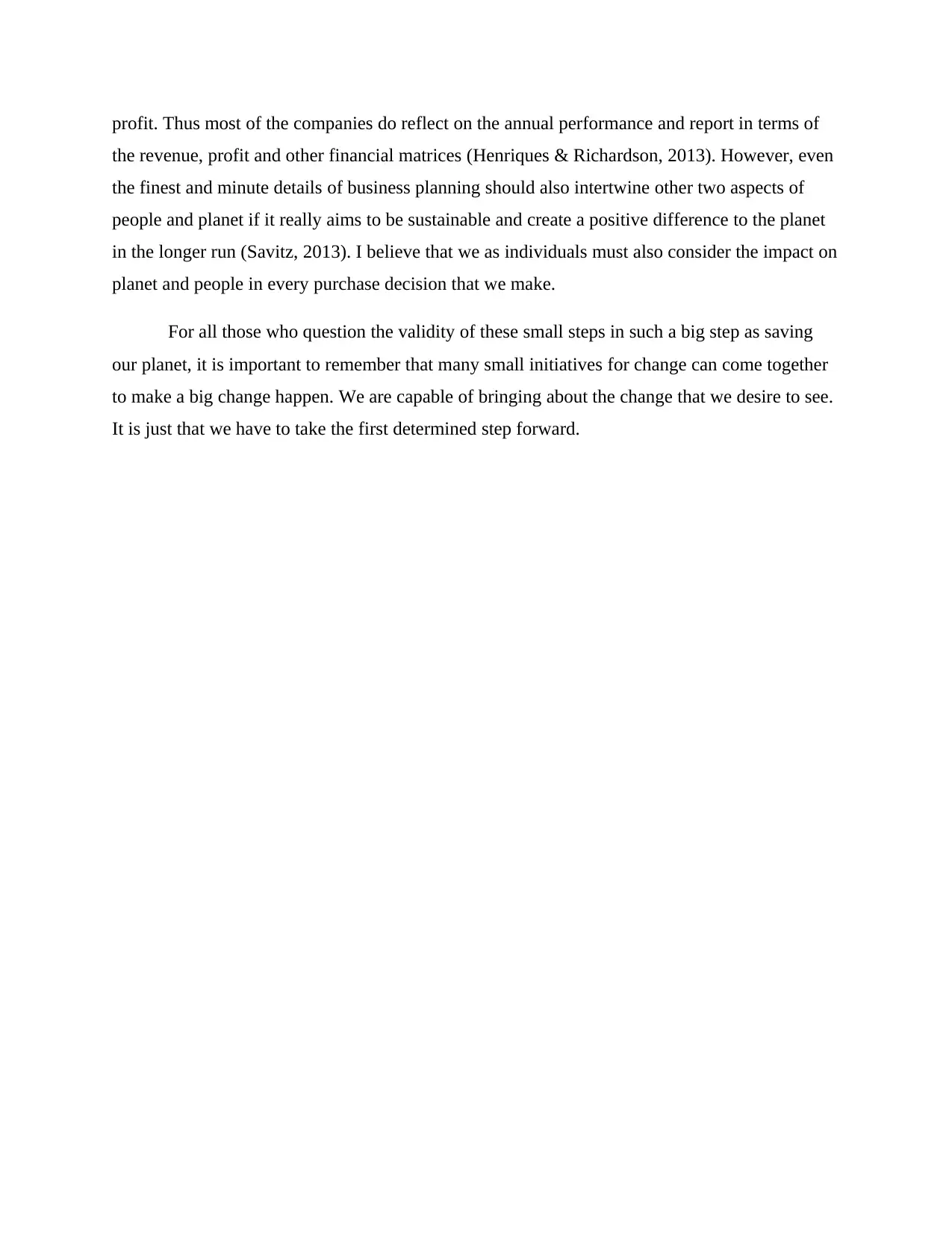
profit. Thus most of the companies do reflect on the annual performance and report in terms of
the revenue, profit and other financial matrices (Henriques & Richardson, 2013). However, even
the finest and minute details of business planning should also intertwine other two aspects of
people and planet if it really aims to be sustainable and create a positive difference to the planet
in the longer run (Savitz, 2013). I believe that we as individuals must also consider the impact on
planet and people in every purchase decision that we make.
For all those who question the validity of these small steps in such a big step as saving
our planet, it is important to remember that many small initiatives for change can come together
to make a big change happen. We are capable of bringing about the change that we desire to see.
It is just that we have to take the first determined step forward.
the revenue, profit and other financial matrices (Henriques & Richardson, 2013). However, even
the finest and minute details of business planning should also intertwine other two aspects of
people and planet if it really aims to be sustainable and create a positive difference to the planet
in the longer run (Savitz, 2013). I believe that we as individuals must also consider the impact on
planet and people in every purchase decision that we make.
For all those who question the validity of these small steps in such a big step as saving
our planet, it is important to remember that many small initiatives for change can come together
to make a big change happen. We are capable of bringing about the change that we desire to see.
It is just that we have to take the first determined step forward.
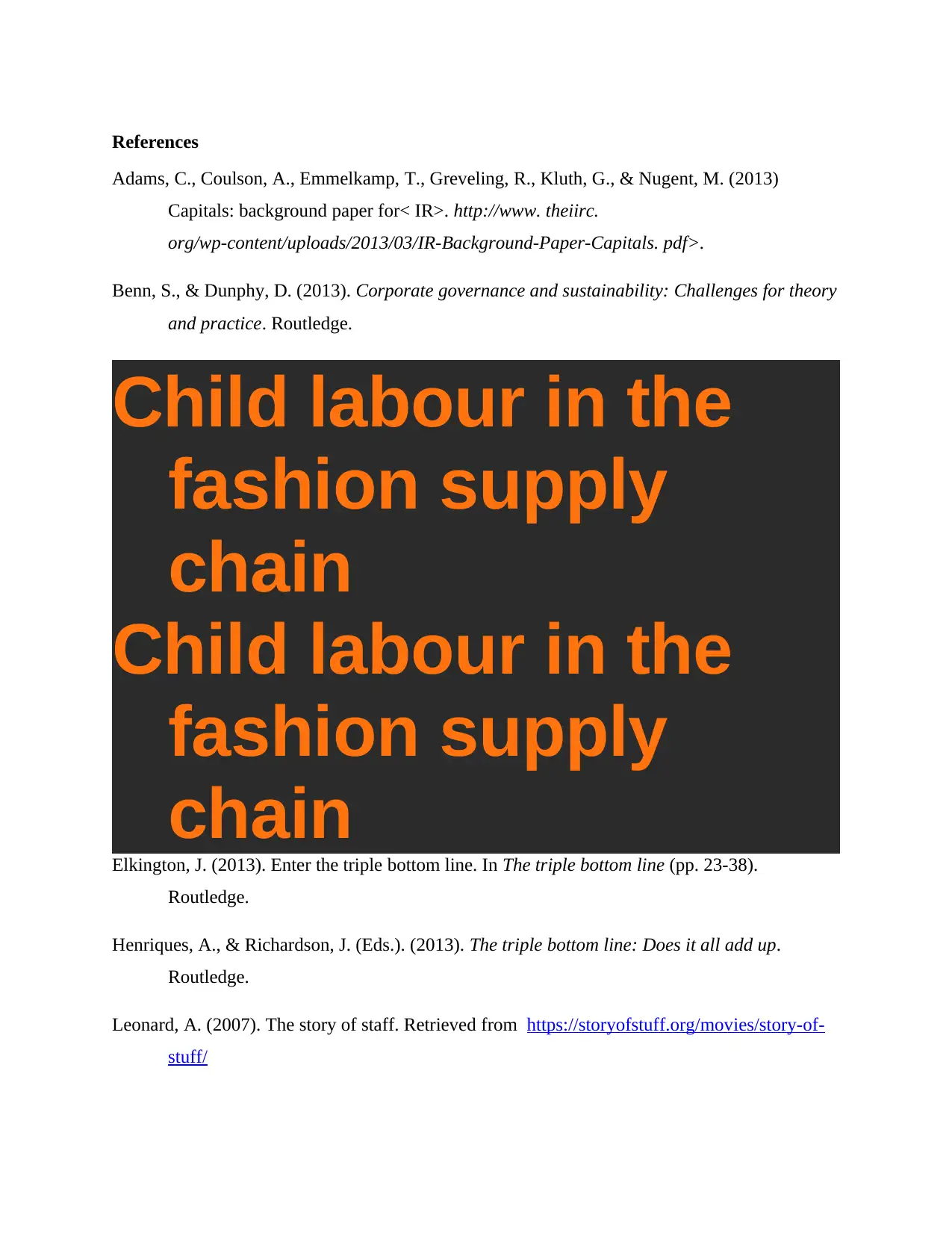
References
Adams, C., Coulson, A., Emmelkamp, T., Greveling, R., Kluth, G., & Nugent, M. (2013)
Capitals: background paper for< IR>. http://www. theiirc.
org/wp-content/uploads/2013/03/IR-Background-Paper-Capitals. pdf>.
Benn, S., & Dunphy, D. (2013). Corporate governance and sustainability: Challenges for theory
and practice. Routledge.
Child labour in the
fashion supply
chain
Child labour in the
fashion supply
chainElkington, J. (2013). Enter the triple bottom line. In The triple bottom line (pp. 23-38).
Routledge.
Henriques, A., & Richardson, J. (Eds.). (2013). The triple bottom line: Does it all add up.
Routledge.
Leonard, A. (2007). The story of staff. Retrieved from https://storyofstuff.org/movies/story-of-
stuff/
Adams, C., Coulson, A., Emmelkamp, T., Greveling, R., Kluth, G., & Nugent, M. (2013)
Capitals: background paper for< IR>. http://www. theiirc.
org/wp-content/uploads/2013/03/IR-Background-Paper-Capitals. pdf>.
Benn, S., & Dunphy, D. (2013). Corporate governance and sustainability: Challenges for theory
and practice. Routledge.
Child labour in the
fashion supply
chain
Child labour in the
fashion supply
chainElkington, J. (2013). Enter the triple bottom line. In The triple bottom line (pp. 23-38).
Routledge.
Henriques, A., & Richardson, J. (Eds.). (2013). The triple bottom line: Does it all add up.
Routledge.
Leonard, A. (2007). The story of staff. Retrieved from https://storyofstuff.org/movies/story-of-
stuff/
⊘ This is a preview!⊘
Do you want full access?
Subscribe today to unlock all pages.

Trusted by 1+ million students worldwide
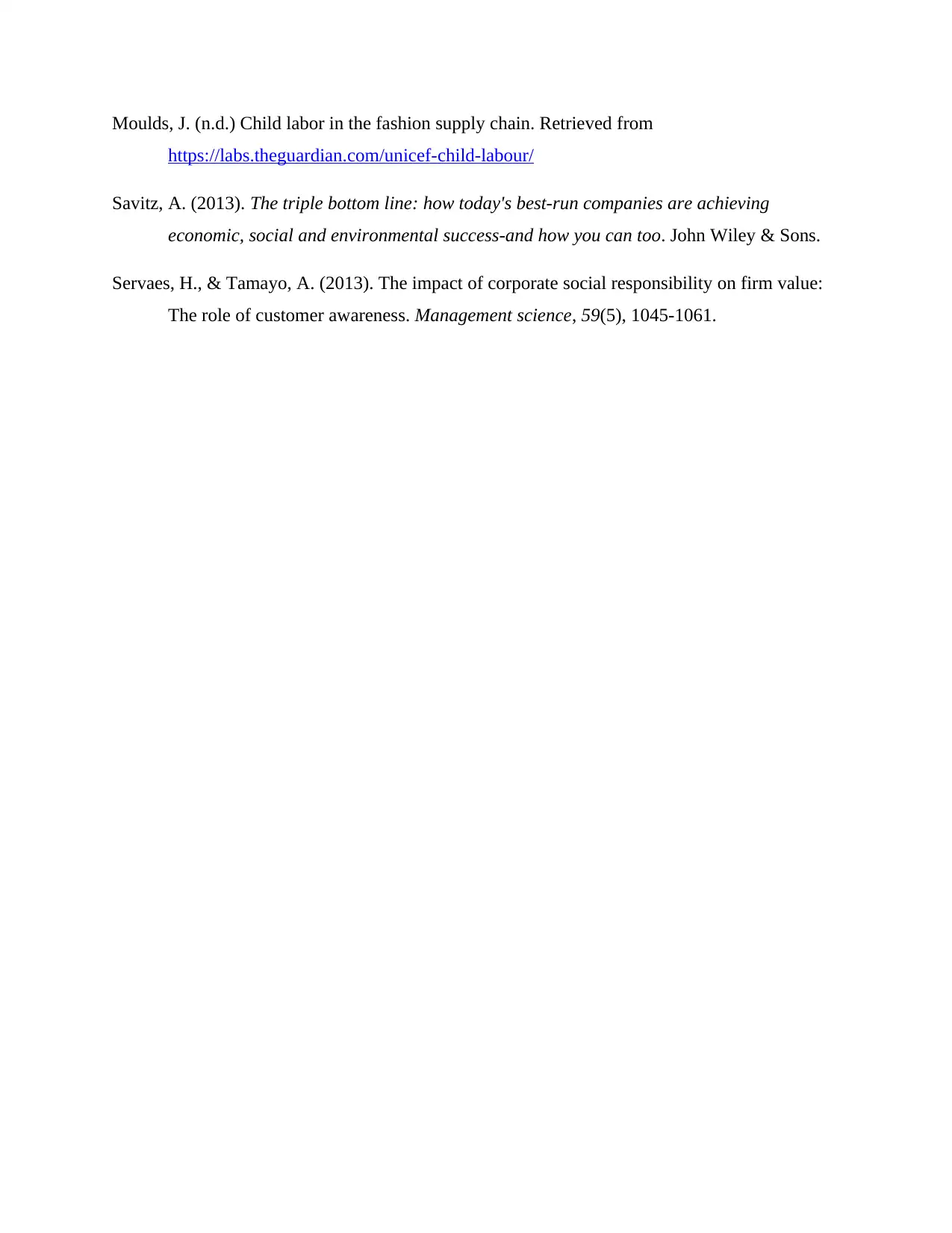
Moulds, J. (n.d.) Child labor in the fashion supply chain. Retrieved from
https://labs.theguardian.com/unicef-child-labour/
Savitz, A. (2013). The triple bottom line: how today's best-run companies are achieving
economic, social and environmental success-and how you can too. John Wiley & Sons.
Servaes, H., & Tamayo, A. (2013). The impact of corporate social responsibility on firm value:
The role of customer awareness. Management science, 59(5), 1045-1061.
https://labs.theguardian.com/unicef-child-labour/
Savitz, A. (2013). The triple bottom line: how today's best-run companies are achieving
economic, social and environmental success-and how you can too. John Wiley & Sons.
Servaes, H., & Tamayo, A. (2013). The impact of corporate social responsibility on firm value:
The role of customer awareness. Management science, 59(5), 1045-1061.
1 out of 7
Your All-in-One AI-Powered Toolkit for Academic Success.
+13062052269
info@desklib.com
Available 24*7 on WhatsApp / Email
![[object Object]](/_next/static/media/star-bottom.7253800d.svg)
Unlock your academic potential
Copyright © 2020–2025 A2Z Services. All Rights Reserved. Developed and managed by ZUCOL.